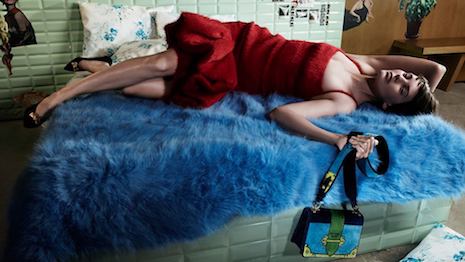- About
- Subscribe Now
- New York,
April 23, 2018

 Prada was one of the mega brands that grew its ecommerce availability the most. Image credit: Prada
Prada was one of the mega brands that grew its ecommerce availability the most. Image credit: Prada
As luxury ecommerce adoption grows, brands are also expanding the number of products they are selling online, according to a new report from ContactLab.
“The Online Offer Dive & Pricing Landscape” report for fall/winter 2018 found that the top 18 brands in soft luxury goods grew their ecommerce product availability and viewability by 30 percent. While many luxury brands were hesitant to embrace ecommerce at first due to worries of tarnishing exclusivity, today even big-ticket items are being sold online.
ContactLab was reached for comment.
Ecommerce availability
Among the sample of brands, Dolce & Gabbana and Brunello Cucinelli were two of the labels that aggressively increased the number of products sold online, with respective 172 percent and 177 percent increases.
ContactLab’s report found that ready-to-wear was the category that was most expanded, with a 60 percent growth in apparel availability across brands.
Brunello Cucinelli has expanded its ecommerce assortment. Image credit: Brunello Cucinelli
Whereas ready-to-wear was a category that many kept offline for years, today all of the brands in ContactLab’s sample sell clothing via ecommerce.
Included in the report is Prada, which made its first foray into selling ready-to-wear online in 2016 with Net-A-Porter and Mr Porter (see story). Since then, Prada has expanded its direct-operated ecommerce site to include apparel.
Jewelry, footwear and home décor also saw significant increases in ecommerce availability.
The report also looked at the price points of merchandise available online.
ContactLab discovered that across the sample, entry-level prices grew 14 percent. Categories such as small leather goods tend to have accessible costs of $200 to $300. However, handbags carry more exclusive prices, with many labels featuring starting prices of $1,000 or more.
Handbags have one of the highest starting prices among ecommerce selections. Image credit: Hermès
ContactLab found that the highest price points increased 8 percent. Available that season were items such as a $34,000 Gucci handbag or a $301,400 necklace from Hermès.
Despite the availability of big-ticket goods online, some brands still keep certain items offline. For instance, Hermès’ coveted Birkin bag remains a bricks-and-mortar exclusive.
Most brands have a wide range between their highest and lowest priced items, but brands including Fendi, Tod’s and Saint Laurent have more concentrated offers.
Online opportunity
Even categories that feature high price points are finding a place online.
Online retailer Net-A-Porter is investing in yielding high-end jewelry brands who lack an online retail presence to help affluent shoppers accomplish all of their buying needs within its platform.
The ecommerce platform is launching a flagship jewelry store online, where it will bring in couture watch and jewelry brands, many of whom have never had a digital retail presence. A dedicated hub for prestigious brands such as Cartier, Jaeger-LeCoultre, Piaget and Chopard will include heightened customer service elements to better cater to the high-net-worth shopper (see story).
At the Condé Nast International Luxury Conference, Yoox Net-A-Porter Group CEO Federico Marchetti noted that there is not a limit to what luxury consumers will spend online (see story).
Even brands that were longtime ecommerce holdouts have embraced ecommerce, with Céline a notable recent entrant to online selling (see story).
Having an ecommerce presence is a smart strategy to reach today's digitally inclined luxury buyers. Luxury consumers are increasingly using digital channels within their purchase paths, with a mere 22 percent starting and ending their journey offline.
A new report from McKinsey entitled “The age of digital Darwinism” highlights luxury brands’ growing need for digital competency, as even boomers spend significant time online and on smartphones. Whereas the conversation in the last few years has largely been about translating a luxury experience to a screen, McKinsey now sees expectations hinging on digital impacting the bricks-and-mortar environment.
Today, online sales of personal luxury goods are $20 billion, making up 8 percent of total luxury sales. By 2025, McKinsey projects this figure will more than triple to $74 billion, with about one in five luxury sales happening online (see story).
Share your thoughts. Click here